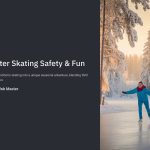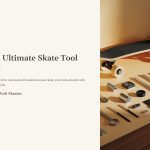 Winter transforms the skating experience into a unique seasonal adventure, blending thrill with caution. As temperatures drop, skaters—both ice and inline—must adapt to the cold environment to ensure safety, performance, and enjoyment. Recently, colder winters have extended outdoor skating seasons in many regions, prompting more people to lace up in snowy parks or frozen lakes. However, with this rising trend comes an increased need for preparation and awareness. Understanding how to properly use skates during the winter season not only prevents accidents but also enhances overall experience.
Winter transforms the skating experience into a unique seasonal adventure, blending thrill with caution. As temperatures drop, skaters—both ice and inline—must adapt to the cold environment to ensure safety, performance, and enjoyment. Recently, colder winters have extended outdoor skating seasons in many regions, prompting more people to lace up in snowy parks or frozen lakes. However, with this rising trend comes an increased need for preparation and awareness. Understanding how to properly use skates during the winter season not only prevents accidents but also enhances overall experience.
From thermal gear and blade care to surface awareness and energy conservation, mastering the nuances of winter skating empowers you to glide through the cold with confidence and joy.

Choose the Right Skates for Winter Conditions
Choosing the appropriate skates is crucial when skating in cold temperatures. For ice skating, figure skates or hockey skates with properly sharpened blades provide better grip on frosty surfaces. Inline skaters should opt for models with larger wheels (at least 90mm) and winter-specific grip tires if skating on dry pavement.
Also consider insulated boot materials to retain warmth, especially during longer skating sessions. Skates with a snug yet breathable liner help reduce sweat accumulation, which can cause your feet to get cold faster. Avoid low-quality skates that lack ankle support, as icy terrains demand better control and balance.

Dress Warmly but Flexibly: Layer Like a Pro
When skating in winter, layering is your best friend. Start with a moisture-wicking base layer to keep sweat off your skin, followed by an insulating mid-layer (like fleece or wool), and finish with a windproof, water-resistant outer shell. Gloves are a must—not just for warmth but to protect your hands in case of falls.
Don’t overdress though. Too many heavy layers can restrict your movement. Opt for performance-oriented gear designed for winter sports. Ensure your socks are thermal and breathable; cotton socks should be avoided as they retain moisture and cool down rapidly.

Maintain Your Skates: Winter Blade and Wheel Care
Cold weather can dull blades faster and affect wheel flexibility. Ice skaters should wipe blades dry immediately after use to prevent rusting. Use blade guards during transit and sharpening should be done more frequently in winter, especially if you’re skating on outdoor rinks with rougher ice surfaces.
Inline skaters should check their wheels for cracks due to hardening from cold. Swap to winter wheels with better grip, and lubricate bearings with low-temperature-resistant grease. Keeping your equipment in a warm, dry place extends its life and ensures optimal performance.

Learn to Fall and Stop Safely on Icy Surfaces
Falls are more common on ice or snow-covered paths, so mastering safe falling techniques is essential. Keep your knees slightly bent and your body low to improve balance. If you fall, try to roll rather than catch yourself with your hands. Wrist guards, knee pads, and helmets are strongly recommended even for experienced skaters.
Learning winter-specific stopping methods like the “T-stop” or “snowplow” can help you maintain control. Don’t use brakes that may fail on icy surfaces; instead, use your edge or foot position to create friction and stop safely.

Choose Safe Skating Locations and Know the Risks
Not all winter surfaces are created equal. Stick to well-maintained ice rinks or known skate-friendly parks. For outdoor ice, always check thickness—minimum 4 inches for one person—and avoid skating near cracks, slush, or snow-covered areas that may conceal hazards.
For inline skating, choose clear, salted paths free from ice patches or heavy snow. Avoid secluded or steep areas where help may be hard to reach. Always skate during daylight or in well-lit zones, and consider skating with a buddy for added safety.

Stay Energized and Monitor Your Body in Cold
Skating in cold weather demands more energy. Bring warm drinks and energy snacks like granola bars or nuts. Take breaks frequently to warm up your hands and feet. If you start feeling numb, dizzy, or overly fatigued, it’s time to rest or stop.
Monitor for signs of frostbite (numbness, pale skin) and hypothermia (shivering, confusion). Knowing when to push and when to pause is crucial in winter skating. Stay alert, stay safe, and skate smart.
*Capturing unauthorized images is prohibited*







